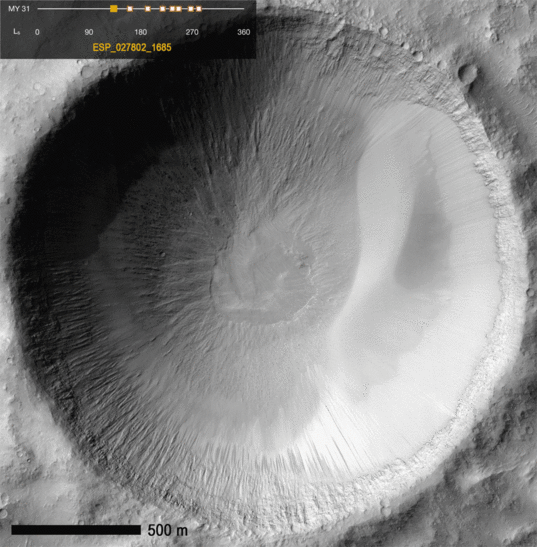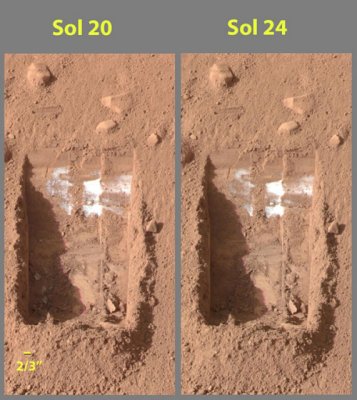It looks like you're using an Ad Blocker.
Please white-list or disable AboveTopSecret.com in your ad-blocking tool.
Thank you.
Some features of ATS will be disabled while you continue to use an ad-blocker.
17
share:
Every now and again, I visit the Planetary Society blogs in search of some interesting stories and pictures
related to space and the Solar System.
Now, you most likely have already heard about seasonal streaks on Mars that could be attributed to briny water or even just wet mud running down the martian slopes and crater walls. They are called Recurring Slope Lineae (RSL). I just came across this blog: What’s Seeping on Mars? Recurring Slope Lineae which provides more information about this phenomenon, as well as interesting details about how and when it was discovered.
But the most interesting piece of information for me, is that these streaks seem to follow the Sun, always forming on the warmest slopes.

In other words, RSL are most active on the slopes that receive more direct sunlight. The RSL activity also seems to slow down when the air above it is particularly dusty, meaning that more of the Sun's light is blocked and the temperatures in that area are cooler.
Before I found this blog, I was sceptical of the proposals that water could be responsible for these features, attributing them to sand run-offs instead. But now I'm gravitating closer to the water/mud theory. Many questions still remain unanswered, for example, where does this water come from.
Now, you most likely have already heard about seasonal streaks on Mars that could be attributed to briny water or even just wet mud running down the martian slopes and crater walls. They are called Recurring Slope Lineae (RSL). I just came across this blog: What’s Seeping on Mars? Recurring Slope Lineae which provides more information about this phenomenon, as well as interesting details about how and when it was discovered.
Initial Discovery
It was another student, Lujendra (“Luju”) Ojha, also working on DTM production, who finally caught the small lineae on crater walls growing between images. After Luju raised a flag to the HiRISE Principal Investigator Alfred McEwen, the hunt was on to track down the origin of the strange lineae. They were first discovered in the mid-latitude southern highlands (published by Alfred and coauthros in Science in 2011), but are now known to be abundant in equatorial regions (announced in Nature this year), particularly within the deep canyons of Valles Marineris.
But the most interesting piece of information for me, is that these streaks seem to follow the Sun, always forming on the warmest slopes.

In other words, RSL are most active on the slopes that receive more direct sunlight. The RSL activity also seems to slow down when the air above it is particularly dusty, meaning that more of the Sun's light is blocked and the temperatures in that area are cooler.
Before I found this blog, I was sceptical of the proposals that water could be responsible for these features, attributing them to sand run-offs instead. But now I'm gravitating closer to the water/mud theory. Many questions still remain unanswered, for example, where does this water come from.
Thank you for bringing this to us! I really enjoy reading about the discoveries on Mars! S+F!
Those evil big oil bastards are probably fracking there too!! Sonzah bitches!!
edit on 22-5-2014 by HUMBLEONE because: Embrace the
Absurdity!
Thank heavens I'm not a scientist...
Being non scientific gives me the upper hand...I already know there is water and life on Mars. It's like a belief in God...I just know it
Being non scientific gives me the upper hand...I already know there is water and life on Mars. It's like a belief in God...I just know it
Why isn't NASA using satellites to find out whether there is groundwater under the surface of mars? Earth as ice caps and groundwater. Why not
findout if Mars has groundwater? Use satellites or drill for it. Maybe they already know. NASA uses GRACE satellites to monitor groundwater on
Earth.
Thanks for sharing.
I think there are many instances of water and vegetation on Mars. I am a big fan of JP Skippers photo analysis of Mars images.
I think there are many instances of water and vegetation on Mars. I am a big fan of JP Skippers photo analysis of Mars images.
a reply to: wildespace
What do you think it is?
Personally I have some theories about Mars and some science in general. That until it is better understood announcing that things are not as we have been led to believe leads to pitchforks and torches...They tend to studies on public reactions and spoon feed them.
What do you think it is?
Personally I have some theories about Mars and some science in general. That until it is better understood announcing that things are not as we have been led to believe leads to pitchforks and torches...They tend to studies on public reactions and spoon feed them.
a reply to: TamtammyMacx
It is pretty much settled that there are vast glaciers under the suface of Mars.
www.scientificamerican.com...
It is pretty much settled that there are vast glaciers under the suface of Mars.
www.scientificamerican.com...
Use satellites how? Drill for it how?
Use satellites or drill for it.
GRACE uses changes in local gravity fields to monitor changes in groundwater quantities. If there is liquid water beneath Mars' surface it probably would be quite static so there wouldn't be any indication to show its presence. But perhaps in the future there will be gravity mapping missions to Mars. Perhaps the data from them could be used.
NASA uses GRACE satellites to monitor groundwater on Earth.
a reply to: Phage
I second this. Remote sensing for water underground from space ... how are you going to do it? They did it with the GRS instrument a decade ago and showed that there is a cryosphere poleward of around 50° latitudes. en.wikipedia.org...
I second this. Remote sensing for water underground from space ... how are you going to do it? They did it with the GRS instrument a decade ago and showed that there is a cryosphere poleward of around 50° latitudes. en.wikipedia.org...
I think salty water in the soil (mud) could exist for short times on Mars under the right conditions in a small area.
The 2008 Phoenix lander found water ice just a few inches below the surface:

Link
You can see it evaporating (sublimating) as it is exposed to the sun.
This may mean there is a permafrost layer on Mars. Phoenix landed close to the Martian north pole, so I don't know how extensive this permafrost layer is on a global scale.
The 2008 Phoenix lander found water ice just a few inches below the surface:

Link
You can see it evaporating (sublimating) as it is exposed to the sun.
This may mean there is a permafrost layer on Mars. Phoenix landed close to the Martian north pole, so I don't know how extensive this permafrost layer is on a global scale.
a reply to: ionwind
My former officemate did her thesis simulating ice stability (numerical models and lab experiments) at high Martian latitudes. Her main goal was to finish before Phoenix landed and proved her wrong. Fortunately, it didn't, and her first postdoc was working on the Phoenix team. The predictions from her models were that ice IS stable at high northern latitudes, under the regolith, though I don't think anyone had really predicted it would be so stable so close to the surface that it would be seen just by digging a bit.
And Phoenix landed at 68°N, which is farther away from the north pole than some might think.
My former officemate did her thesis simulating ice stability (numerical models and lab experiments) at high Martian latitudes. Her main goal was to finish before Phoenix landed and proved her wrong. Fortunately, it didn't, and her first postdoc was working on the Phoenix team. The predictions from her models were that ice IS stable at high northern latitudes, under the regolith, though I don't think anyone had really predicted it would be so stable so close to the surface that it would be seen just by digging a bit.
And Phoenix landed at 68°N, which is farther away from the north pole than some might think.
new topics
-
God's Righteousness is Greater than Our Wrath
Religion, Faith, And Theology: 2 hours ago -
Electrical tricks for saving money
Education and Media: 5 hours ago -
VP's Secret Service agent brawls with other agents at Andrews
Mainstream News: 6 hours ago -
Sunak spinning the sickness figures
Other Current Events: 7 hours ago -
Nearly 70% Of Americans Want Talks To End War In Ukraine
Political Issues: 7 hours ago -
Late Night with the Devil - a really good unusual modern horror film.
Movies: 9 hours ago -
Cats Used as Live Bait to Train Ferocious Pitbulls in Illegal NYC Dogfighting
Social Issues and Civil Unrest: 10 hours ago
top topics
-
VP's Secret Service agent brawls with other agents at Andrews
Mainstream News: 6 hours ago, 9 flags -
Florida man's trip overseas ends in shock over $143,000 T-Mobile phone bill
Social Issues and Civil Unrest: 17 hours ago, 8 flags -
Cats Used as Live Bait to Train Ferocious Pitbulls in Illegal NYC Dogfighting
Social Issues and Civil Unrest: 10 hours ago, 8 flags -
Electrical tricks for saving money
Education and Media: 5 hours ago, 4 flags -
Bobiverse
Fantasy & Science Fiction: 17 hours ago, 3 flags -
HORRIBLE !! Russian Soldier Drinking Own Urine To Survive In Battle
World War Three: 14 hours ago, 3 flags -
Nearly 70% Of Americans Want Talks To End War In Ukraine
Political Issues: 7 hours ago, 3 flags -
Sunak spinning the sickness figures
Other Current Events: 7 hours ago, 3 flags -
Late Night with the Devil - a really good unusual modern horror film.
Movies: 9 hours ago, 2 flags -
The Good News According to Jesus - Episode 1
Religion, Faith, And Theology: 12 hours ago, 1 flags
active topics
-
Cats Used as Live Bait to Train Ferocious Pitbulls in Illegal NYC Dogfighting
Social Issues and Civil Unrest • 20 • : Asher47 -
Nearly 70% Of Americans Want Talks To End War In Ukraine
Political Issues • 12 • : Asher47 -
VP's Secret Service agent brawls with other agents at Andrews
Mainstream News • 39 • : Asher47 -
Electrical tricks for saving money
Education and Media • 4 • : Lumenari -
New whistleblower Jason Sands speaks on Twitter Spaces last night.
Aliens and UFOs • 54 • : Ophiuchus1 -
DONALD J. TRUMP - 2024 Candidate for President - His Communications to Americans and the World.
2024 Elections • 514 • : WeMustCare -
The Acronym Game .. Pt.3
General Chit Chat • 7744 • : bally001 -
Truth Social goes public, be careful not to lose your money
Mainstream News • 128 • : Astyanax -
Sunak spinning the sickness figures
Other Current Events • 5 • : glen200376 -
SETI chief says US has no evidence for alien technology. 'And we never have'
Aliens and UFOs • 44 • : MikeDeGrasseTyson
17
